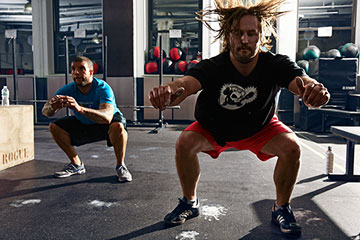
CrossFitters work out in a New York City box. CrossFit preaches constantly varied, high-intensity, functional movement.
Outside, it's a few degrees south of zero. But inside this CrossFit gym in Grand Forks, N.D., a half-dozen fitness nuts--three men, three women--are just warming up. Tom Harmon, a former Army reservist who runs this 5,300-sq.-ft. space in a mall, is about to put his troops through the workout of the day: five dead lifts, raising a barbell from the floor to hip level; then seven burpees, a CrossFit favorite in which you hit the floor from a standing position, do a push-up, then jump in the air, repeat and rinse; then nine wall ball shots, tossing a medicine ball above a marked spot on the wall. The goal: repeat this exercise cycle as many times as possible in 12 minutes.
Harmon cranks up the music. "Ten seconds on the clock, guys," he says. "Three, two, one and go." The CrossFitters gamely start grinding. Harmon--who opened this location, one of two CrossFit outposts in Grand Forks (pop. 53,000), about two years ago--estimates that about 50% of his clients quit after three months. "There's a big commitment level to this," he says. "People get weeded out pretty quick." About five minutes in, the burpees get slower, the breaths heavier. "Blane, squat," Harmon says. "Nope, get lower. There you go, bud. Good job, bud." The wall clock is inching toward 12 minutes. "One minute, guys, one more," says Harmon. "Push through this." Time. One guy paces around. The other five participants are splayed on the floor. They give each other air-fives from their backs.
CrossFit is what happens when our need to exercise slams into our need for instant gratification. Marathons, triathlons and Tough Mudder events deliver the requisite torture but require lots of training time. Particularly after the holidays, we want chiseled abs and sculpted triceps and a clearer head right now. We're too busy to futz around at the dumbbell rack or run 80 lonely miles a week. And after spending all day tethered to our devices, we're itching to talk to other humans at the gym. Shared suffering, it turns out, is a powerful urge.
People are flocking to CrossFit and other extreme exercise programs; the potential physical and social benefits are undeniable. But as hyperintensive exercise programs increase their reach, more health professionals are raising serious concerns. Lifting heavy weights until you're fatigued can be dangerous, especially if you haven't mastered the proper technique. Lose sight of your physical limits and you can wind up in the ER. "The overarching question is, Do people need to do this, at such high intensity, repeatedly to failure?" says Michael Bergeron, a professor at the University of South Dakota's Sanford School of Medicine and the executive director of the National Institute for Athletic Health & Performance. "Most people don't need to train like that to enhance their health, to look good, to be fit."
CrossFit isn't backing down one rep. "If the criticism is 'Your culture is too aggressive, too abrasive and offensive,' yeah, that may be true," says CrossFit social-media guru and spokesman Russell Berger. "They may have us on that one." The company even embraces its critics: one of the company's cartoon mascots is Pukie, a vomiting clown.
More Reps, More Often
